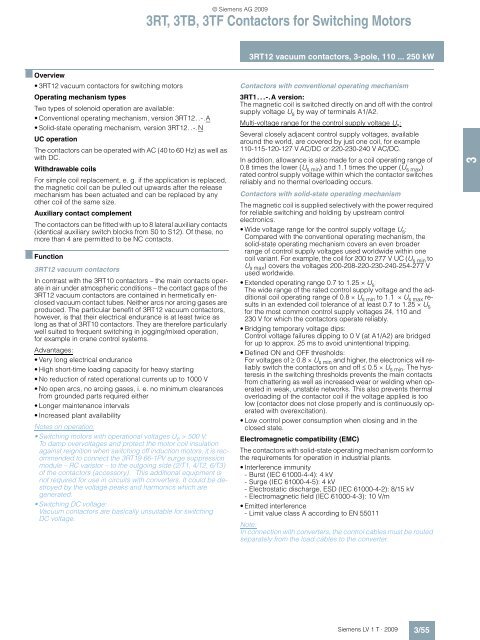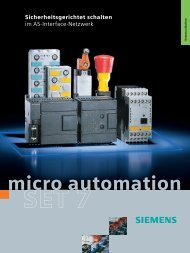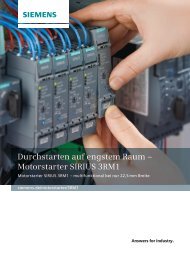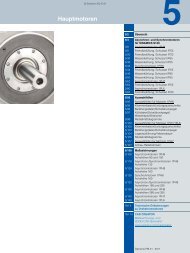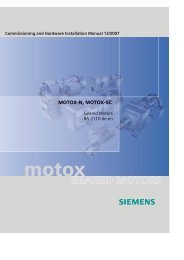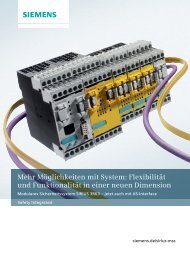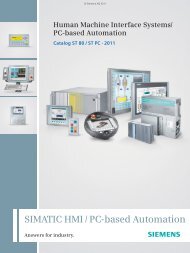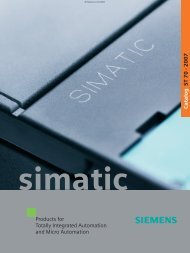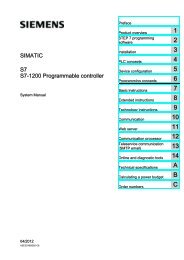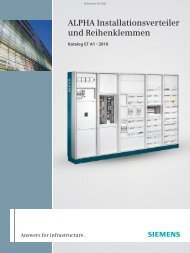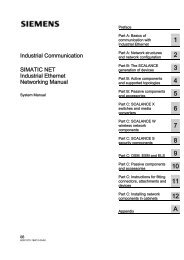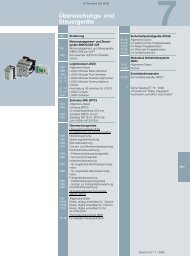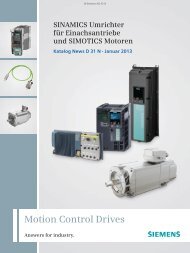Catalog LV1 T 2009 Chapter 3 EN
Catalog LV1 T 2009 Chapter 3 EN
Catalog LV1 T 2009 Chapter 3 EN
You also want an ePaper? Increase the reach of your titles
YUMPU automatically turns print PDFs into web optimized ePapers that Google loves.
■ Overview<br />
3RT12 vacuum contactors for switching motors<br />
Operating mechanism types<br />
Two types of solenoid operation are available:<br />
Conventional operating mechanism, version 3RT12. .-.A<br />
Solid-state operating mechanism, version 3RT12. .-.N<br />
UC operation<br />
The contactors can be operated with AC (40 to 60 Hz) as well as<br />
with DC.<br />
Withdrawable coils<br />
For simple coil replacement, e. g. if the application is replaced,<br />
the magnetic coil can be pulled out upwards after the release<br />
mechanism has been actuated and can be replaced by any<br />
other coil of the same size.<br />
Auxiliary contact complement<br />
The contactors can be fitted with up to 8 lateral auxiliary contacts<br />
(identical auxiliary switch blocks from S0 to S12). Of these, no<br />
more than 4 are permitted to be NC contacts.<br />
■ Function<br />
3RT12 vacuum contactors<br />
In contrast with the 3RT10 contactors – the main contacts operate<br />
in air under atmospheric conditions – the contact gaps of the<br />
3RT12 vacuum contactors are contained in hermetically enclosed<br />
vacuum contact tubes. Neither arcs nor arcing gases are<br />
produced. The particular benefit of 3RT12 vacuum contactors,<br />
however, is that their electrical endurance is at least twice as<br />
long as that of 3RT10 contactors. They are therefore particularly<br />
well suited to frequent switching in jogging/mixed operation,<br />
for example in crane control systems.<br />
Advantages:<br />
Very long electrical endurance<br />
High short-time loading capacity for heavy starting<br />
No reduction of rated operational currents up to 1000 V<br />
No open arcs, no arcing gases, i. e. no minimum clearances<br />
from grounded parts required either<br />
Longer maintenance intervals<br />
Increased plant availability<br />
Notes on operation:<br />
• Switching motors with operational voltages Ue > 500 V:<br />
To damp overvoltages and protect the motor coil insulation<br />
against reignition when switching off induction motors, it is recommended<br />
to connect the 3RT19 66-1PV surge suppression<br />
module – RC varistor – to the outgoing side (2/T1, 4/T2, 6/T3)<br />
of the contactors (accessory). This additional equipment is<br />
not required for use in circuits with converters. It could be destroyed<br />
by the voltage peaks and harmonics which are<br />
generated.<br />
Switching DC voltage:<br />
Vacuum contactors are basically unsuitable for switching<br />
DC voltage.<br />
© Siemens AG <strong>2009</strong><br />
3RT, 3TB, 3TF Contactors for Switching Motors<br />
3RT12 vacuum contactors, 3-pole, 110 ... 250 kW<br />
Contactors with conventional operating mechanism<br />
3RT1. . .-.A version:<br />
The magnetic coil is switched directly on and off with the control<br />
supply voltage Us by way of terminals A1/A2.<br />
Multi-voltage range for the control supply voltage Us: Several closely adjacent control supply voltages, available<br />
around the world, are covered by just one coil, for example<br />
110-115-120-127 V AC/DC or 220-230-240 V AC/DC.<br />
In addition, allowance is also made for a coil operating range of<br />
0.8 times the lower (Usmin ) and 1.1 times the upper (Usmax )<br />
rated control supply voltage within which the contactor switches<br />
reliably and no thermal overloading occurs.<br />
Contactors with solid-state operating mechanism<br />
The magnetic coil is supplied selectively with the power required<br />
for reliable switching and holding by upstream control<br />
electronics.<br />
Wide voltage range for the control supply voltage Us: Compared with the conventional operating mechanism, the<br />
solid-state operating mechanism covers an even broader<br />
range of control supply voltages used worldwide within one<br />
coil variant. For example, the coil for 200 to 277 V UC (Usmin to<br />
Usmax) covers the voltages 200-208-220-230-240-254-277 V<br />
used worldwide.<br />
Extended operating range 0.7 to 1.25 × Us: The wide range of the rated control supply voltage and the additional<br />
coil operating range of 0.8 × Usmin to 1.1 × Usmax results<br />
in an extended coil tolerance of at least 0.7 to 1.25 × Us for the most common control supply voltages 24, 110 and<br />
230 V for which the contactors operate reliably.<br />
Bridging temporary voltage dips:<br />
Control voltage failures dipping to 0 V (at A1/A2) are bridged<br />
for up to approx. 25 ms to avoid unintentional tripping.<br />
Defined ON and OFF thresholds:<br />
For voltages of ≥ 0.8 × Usmin and higher, the electronics will reliably<br />
switch the contactors on and off ≤ 0.5 × Usmin. The hysteresis<br />
in the switching thresholds prevents the main contacts<br />
from chattering as well as increased wear or welding when operated<br />
in weak, unstable networks. This also prevents thermal<br />
overloading of the contactor coil if the voltage applied is too<br />
low (contactor does not close properly and is continuously operated<br />
with overexcitation).<br />
Low control power consumption when closing and in the<br />
closed state.<br />
Electromagnetic compatibility (EMC)<br />
The contactors with solid-state operating mechanism conform to<br />
the requirements for operation in industrial plants.<br />
Interference immunity<br />
- Burst (IEC 61000-4-4): 4 kV<br />
- Surge (IEC 61000-4-5): 4 kV<br />
- Electrostatic discharge, ESD (IEC 61000-4-2): 8/15 kV<br />
- Electromagnetic field (IEC 61000-4-3): 10 V/m<br />
Emitted interference<br />
- Limit value class A according to <strong>EN</strong> 55011<br />
Note:<br />
In connection with converters, the control cables must be routed<br />
separately from the load cables to the converter.<br />
Siemens LV 1 T · <strong>2009</strong><br />
3/55<br />
3


